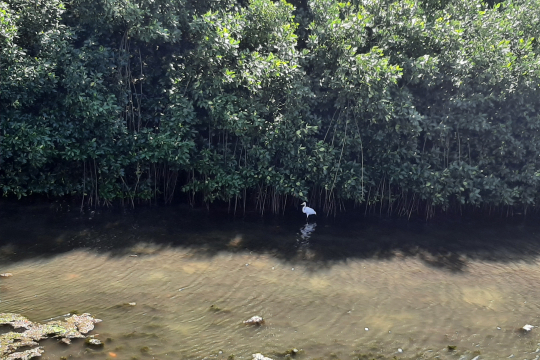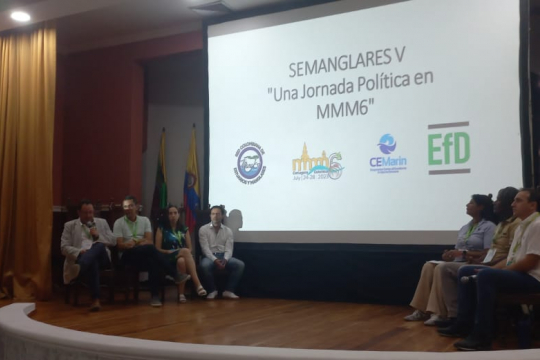Jorge Maldonado, EfD Colombia, was part of the scientific committee of the 6th Mangrove and Macrobenthos Management Conference held in Cartagena last year. During this conference, he and some colleagues led a two-day meeting with several stakeholders to discuss the protection of the mangrove and the implementation of law 2243 in Colombia.
“Besides offering scientific knowledge, researchers can build bridges among stakeholders for the conservation of this ecosystem,” says Jorge Maldonado.
Mangroves are a unique group of trees and shrubs that have many important functions for the ecosystems. They can be found in Asia, Africa, the Caribbean, Ecuador, Colombia, Brazil, Mexico, and the South of the USA. They protect the land from erosion and are a natural breeding farm for fish. Besides offering protection from hurricanes, storms, and tsunamis, they are also used as construction material and material for furniture due to their water resistance.
Many hectares of mangroves have been cut down worldwide for urban development on the coast, mainly for tourism. Since their conditions make them an ideal place to breed shrimps, many mangroves were cut down to build pools for shrimps, which has a strong impact on this ecosystem.
Colombia enacts a law for mangrove protection
In July 2022, the Congress in Colombia enacted a law to conserve the mangroves (law 2243). According to the Ministry of Environment of Colombia, this country has a mangrove area of 290,704 hectares, out of which approximately 75% are on the Pacific coast, 25% in the Caribbean, and 0.07% on the island coastland (1).
An example of how activities for economic development affect the mangrove is the Ciénaga Grande de Santa Marta, which is the coastal estuarine system of the Magdalena River in Colombia. Its mangrove ecosystem is the largest on the Caribbean coast of Colombia and was designated a Ramsar wetland in 1998 due to its ecological importance. This natural system shows great deterioration due to road construction in the last 70 years, deviation of the rivers to use the water for livestock farming and monoculture activities, and climate change (2).
The law 2243 of 2022 has several aims: to guarantee the protection of the mangrove ecosystems, to plan its management and sustainable use, and to foster its conservation and restoration where it has been affected. The territory where the mangroves are situated will be classified according to the use and current conditions of the mangroves: preservation, sustainable use, and restoration. Mining, exploration, and exploitation of hydrocarbon, and aquaculture activities are forbidden. The implementation of the law requires that the Ministry of Environment and Sustainable Development define a committee formed by representatives of different stakeholders to create a strategy for mangrove protection.
Scientific meeting facilitates the gathering of stakeholders around the law
The Vice-minister of Environment and Sustainable Development participated in the meeting in the two-day meeting in Cartagena last year as well as representatives from regional environmental authorities, local communities, the public institution for scientific studies on marine and ocean resources (INVEMAR), and researchers from universities who study mangroves.
“I think that the most important outcome of this meeting was to gather all the stakeholders so they could share their perspective on how mangroves should be managed, what their concerns are, and what the available tools to solve the environmental problems are. This includes findings from science, the experiences of the communities, and national and regional authorities. The participation of the Vice-minister was key because she committed to push the strategy forward,” comments Jorge Maldonado.
Challenges for protecting mangroves
Jorge Maldonado finds that there are two main challenges for implementing the law: one is to gather all the stakeholders to discuss mangrove conservation, and the other is how to handle the diversity of stakeholder’s perspectives.
Mangrove conservation demands collaborative participation among stakeholders, in which every stakeholder has a role to play. Local communities provide traditional on-site knowledge about the mangroves because they have continuous contact and a historical relationship with them. They share the territory with them; therefore, they can monitor and follow up on the mangroves.
National authorities need to give support in the field and provide leadership and legal tools to protect, restore, and make sustainable use of the mangrove. Universities and research centers like INVEMAR also play an important role, because they collect, generate, and analyze the scientific knowledge about the mangrove, such as biological and ecological information, and results coming from socio-economic research.
“I find very valuable that a conclusion that came out from this meeting was that it was key for the successful implementation of the law to consider the vision and needs that local communities have on mangroves,” says Jorge Maldonado.
He also adds: “The national authority may be interested in protecting the mangroves, however, their environmental concerns along the country are diverse, and they lack time and human resources to accelerate the strategy. This is why researchers are needed to bring together the stakeholders and initiate a dialogue”. Jorge Maldonado and his colleagues will present a suggested working schedule to the Vice-Minister of Environment on how to develop strategies for mangrove protection.
This meeting was coordinated by the Colombian Network of Estuaries and Mangroves (in Spanish REDSEM – Red Colombiana de Estuarios y Manglares). This network was created by a joint effort of universities and research centers in Colombia as a tool to promote the scientific study, conservation and management of these socio-ecosystems. It also supports the exchange of knowledge and dialogue among stakeholders from different social sectors. Every two years REDSEM organizes the National Seminar on the Socio-ecosystems of mangroves (in Spanish SEMANGLARES). The referred meeting in this news article was the 5th seminar of SEMANGLARES held during the Mangrove Macrobenthos Management Meeting (MMM6) in July 2023.
-
This data was taken from the website of the Colombian Ministry of Environment and Sustainable Development (in Spanish)
-
This information comes from the report “La ciénaga renace de las semillas” from Magazine Pesquisa Javeriana (in Spanish)
By: Manuela Fonseca

